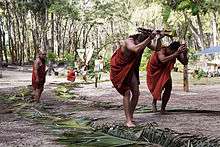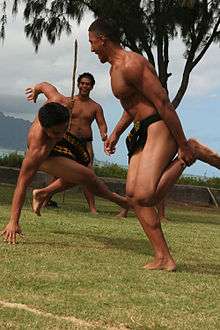Makahiki


The Makahiki season is the ancient Hawaiian New Year festival, in honor of the god Lono of the Hawaiian religion.
It is a holiday covering four consecutive lunar months, approximately from October or November through February or March. The focus of the season is a celebration of the bounty of the land. In antiquity, many religious ceremonies occurred during this period. Commoners stopped work, made offerings to the chief or aliʻi, and then spent their time practicing sports, feasting, dancing and renewing communal bonds. During the four lunar months of the Makahiki season warfare was forbidden which was used as "a ritually inscribed means to assure that nothing would adversely affect the new crops."[1]
Today, the Aloha Festivals (originally Aloha Week) celebrate the Makahiki tradition.[2]
Festivities
The Makahiki festival was celebrated in three phases. The first phase was a time of spiritual cleansing and making hoʻokupu, offerings to the gods. The Konohiki, a class of chiefs that managed land, provided the service of tax collector, collected agricultural and aquacultural products such as pigs, taro, sweet potatoes, dry fish, kapa and mats. Some offerings were in the form of forest products such as feathers. The Hawaiian people had no money or other similar medium of exchange. These were offered on the altars of Lono at heiau - temples - in each district around the island. Offerings were also made at the ahu, stone altars set up at the boundary lines of each community.
All war was outlawed to allow unimpeded passage of the image of Lono. The festival proceeded in a clockwise circle around the island as the image of Lono (Akua Loa, a long pole with a strip of tapa and other embellishments attached) was carried by the priests. At each ahupuaʻa (each community also is called an ahupuaʻa) the caretakers of that community presented hoʻokupu to the Lono image, a fertility god who caused things to grow and who gave plenty and prosperity to the islands. The Akua Loa was adorned with white kapa streamers and the king placed a niho palaoa necklace on the deity.[1] During a certain time the deities couldn't be upright therefore were laid down or put horizontally as a “sign of homage to the king."[1]
The second phase was a time of celebration: of hula dancing, of sports (boxing, wrestling, sliding on sleds, javelin marksmanship, bowling, surfing, canoe races, relays, and swimming), of singing and of feasting. One of the best preserved lava sled courses is the Keauhou Holua National Historic Landmark.[3]
In the third phase, the waʻa ʻauhau — tax canoe — was loaded with hoʻokupu and taken out to sea where it was set adrift as a gift to Lono.[4] At the end of the Makahiki festival, the chief would go off shore in a canoe. When he came back in he stepped on shore and a group of warriors threw spears at him. He had to deflect or parry the spears to prove his worthiness to continue to rule.
Arrivals during the season
A royal birth during the season was sometimes given the name Lono i ka makahiki.
The sails and masts of Captain James Cook's ship resembled Lono's Akua Loa. Captain Cook arrived at Kealakekua Bay, near a large heiau to Lono, during the Makahiki season in 1778.
Origin
The ancient Hawaiians split the year into two seasons.[1] The first was called the Makahiki season which was a period of four lunar months. The second lasted eight lunar months where rituals of Kū were practiced.[1] In the Hawaiian language, the word Makahiki means "year"[2] as well as the change from harvest time to the beginning of the agricultural season. This probably came from Makaliʻi hiki the rising of the Pleiades, known in Hawaii as the Makali'i, which occurred about this time.[5] It might also come from ma Kahiki, meaning roughly "as in Tahiti", since the legend of Lono is associated with voyages to and from Tahiti. Its origins are linked to the "return" of Lono, during one of the early migrations, in the form of a mortal man.[6]
Timing
The beginning of Makahiki generally is fixed each year by astronomical observations. On the Island of Hawai`i, when Makali'i (Pleiades) star cluster rises shortly after sunset, usually on November 17, the rising of the following first crescent moon marks the beginning of the season. On O`ahu, it may begin when the star `A`a (Sirius) appears in conjunction with a particular land form high on a cliff.
See also
References
- 1 2 3 4 5 Kirch, Patrick Vinton (2010). "How Chiefs Became Kings: Divine Kingship and the Rise of Archaic States in Ancient Hawai'i" (Web). Berkeley, CA, USA: University of California Press – via ProQuest ebrary. (subscription required (help)).
- 1 2 Mary Kawena Pukui and Samuel Hoyt Elbert (2003). "lookup of makahiki ". in Hawaiian Dictionary. Ulukau, the Hawaiian Electronic Library, University of Hawaii Press. Retrieved September 21, 2010.
- ↑ "Hoʻihoʻi Kulana Wahi pana - Restoring Sacred Places" (PDF). Kamehameha Investment Corporation. 2008. Retrieved September 21, 2010.
- ↑ Mary Kawena Pukui and Samuel Hoyt Elbert (2003). "lookup of waʻa ʻauhau ". in Hawaiian Dictionary. Ulukau, the Hawaiian Electronic Library, University of Hawaii Press. Retrieved September 21, 2010.
- ↑ Mary Kawena Pukui and Samuel Hoyt Elbert (2003). "lookup of Makalii ". in Hawaiian Dictionary. Ulukau, the Hawaiian Electronic Library, University of Hawaii Press. Retrieved September 21, 2010.
- ↑ Veronica S. Schweitzer (2006). "The Pleiades Rise". Coffee Times. Retrieved September 21, 2010.
Further reading
- Handy, E. S. C. Ancient Hawaiian Civilization. Honolulu, HI: Mutual Publishing, 1999.
- Handy, Edward Smith Craighill; Handy, Elizabeth Green; Pukui, Mary Kawena Native Planters in Old Hawaii: Their Life, Lore, and Environment. Honolulu: Bishop Museum Press, 1972 (rev. ed. 1991). ISBN 0-910240-11-6
- "The Rebirth of Makahiki" Article about past and current Makahiki activities. Maui No Ka 'Oi Magazine Vol.10 No.4 (September 2006)
- "Makahiki - The Hawaiian New Year" On-line article on Makahiki traditions.